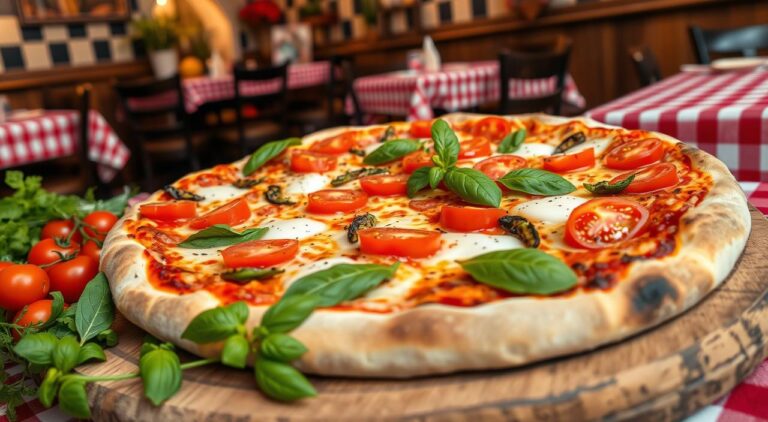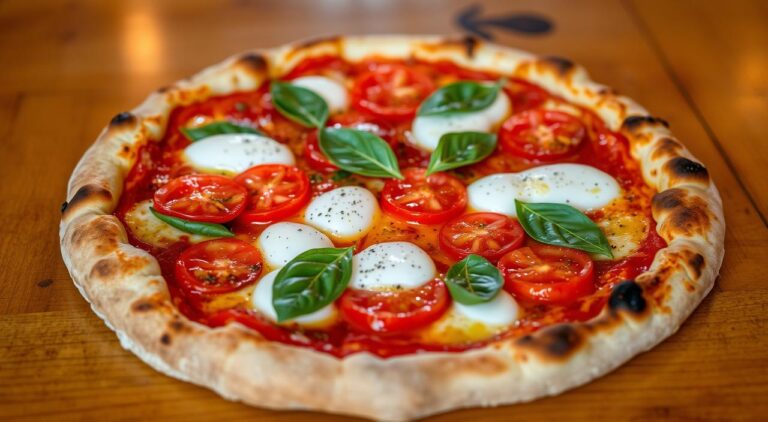India’s rich culinary heritage shines in its diverse and flavorful dishes. The nation’s desserts are a big part of this, from the rich gulab jamun to the crispy jalebi. This article takes you on a journey through India’s traditional sweets. It shows how the country excels in making sweet treats.
Key Takeaways
- Explore the diverse and rich world of Indian desserts, ranging from syrupy gulab jamun to fragrant rasmalai.
- Discover the significance of sweets in Indian culture and the deep-rooted traditions behind these beloved treats.
- Delve into the unique flavors, textures, and regional variations of iconic desserts like jalebi, kulfi, and barfi.
- Appreciate the artistry and skill involved in the preparation of traditional Indian sweets.
- Savor the mouthwatering experience of indulging in the sweet delights of India.
Exploring the Vibrant World of Indian Desserts
India’s culinary heritage is full of rich flavors and detailed traditions. Its desserts are a key part of this heritage. From the sweet gulab jamun to the light rasgulla, these flavors and traditions show the country’s diverse culture.
A Journey Through Flavors and Traditions
The making of Indian desserts combines old techniques from many generations. Each area in India has its own flavors and traditions. This creates a colorful mix of sweet treats. For example, the creamy rasmalai from the north or the flaky shakkarpara from the west show India’s cooking skills.
The Significance of Sweets in Indian Culture
Indian culture is closely linked with sweets. These treats are key during festivals and family events. They symbolize good luck, plenty, and the strong ties in the Indian community.
“Desserts in India are not just a sweet indulgence; they are a reflection of the country’s rich cultural heritage and the deep-rooted traditions that have shaped its culinary landscape.”
Exploring Indian desserts reveals a world of flavors, textures, and customs. From the syrupy gulab jamun to the creamy rasmalai, each dessert has its own story. They invite you to enjoy the sweetness of India’s rich food history.
Gulab Jamun: Delightfully Syrupy and Indulgent
The gulab jamun is a gem among Indian desserts. It has a deep history in Indian food. People all over the world love it.
Making gulab jamun takes time and care. First, milk solids are mixed into a soft dough. Then, the dough is shaped into small balls and fried until golden.
After frying, these balls are soaked in a sweet rose-flavored syrup. This syrup gives them a heavenly smell and a syrupy feel.
“The essence of gulab jamun lies in its perfect balance of flavors and textures – the soft, pillowy interior contrasting with the crisp outer layer, all enveloped in the aromatic rose-infused syrup.”
Gulab jamun is more than just a dessert. It’s a special treat in India, often enjoyed during celebrations and religious events. It brings people together with its amazing taste.

In cities like New Delhi and Kolkata, the smell of gulab jamun fills the air. It invites everyone to enjoy a moment of happiness. Taking a bite, you feel like you’re in India, enjoying its rich food culture.
Jalebi: A Crispy and Sweet Spiral of Delight
The jalebi is a standout among Indian desserts. It’s a deep-fried pastry shaped into a spiral. After frying, it’s soaked in a sweet syrup. This makes it a treat that excites the senses.
The Art of Mastering Jalebi’s Intricate Shape
Making the perfect jalebi is an art. The dough, with flour, yogurt, and spices, is piped into hot oil. This creates the spiral shape. It needs a skilled hand to fry it golden without breaking.
Experts in jalebi make sure each bite is crunchy and chewy. After frying, the pastry is soaked in a sweet syrup. This syrup makes the pastry sticky and sweet.
| Jalebi Attributes | Description |
|---|---|
| Dough Composition | Flour, yogurt, and spices |
| Frying Technique | Piping the dough into hot oil to form spirals |
| Syrup Soak | Immersing the fried pastry in a sweet, fragrant syrup |
The making of jalebi shows India’s deep love for sweets. It’s a tradition that values perfection in every dessert.
Rasmalai: Creamy and Fragrant Cheese Dumplings
In the world of Indian desserts, rasmalai is a standout. It’s a treat that perfectly balances textures and flavors. It shows India’s deep love for sweets.
The Perfect Balance of Textures and Flavors
Rasmalai is a treat that combines soft, spongy cheese dumplings with a creamy sauce. The sweetness of the dumplings matches the richness of the sauce. This mix delights the taste buds.
The secret to great rasmalai is making the chhena just right. These dumplings are made from paneer and milk solids. They’re poached in a sweet liquid to add a floral aroma and sweetness.
The creamy sauce that covers the dumplings is the final touch. It’s made with milk and spices like cardamom and saffron. This sauce makes the chhena even sweeter and more indulgent.
Rasmalai is more than just tasty; it shows the skill in Indian dessert-making. Its mix of soft dumplings and silky sauce is unique. It’s a dish every Indian dessert lover should try.
Rasgulla: The Quintessential Bengali Sweet
Rasgulla is a star in Indian desserts, especially in Bengali cuisine. It’s a soft, spongy sweet made from cottage cheese. People all over love it for its perfect mix of sweet syrup and delicate cheese dumplings.
It started in the late 18th century in Kolkata, West Bengal’s capital. Soon, it became a favorite at celebrations and festivals. Now, it’s a key part of Bengali culture, loved for its taste and its place in history.
Making rasgulla is an art. It begins with fresh cheese curds shaped into small dumplings. Then, they’re cooked in sweet syrup, turning into the soft, spongy rasgulla everyone loves.
| Ingredient | Quantity |
|---|---|
| Milk | 1 liter |
| Lemon Juice or Vinegar | 1-2 tablespoons |
| Sugar | 1 cup |
| Water | 2 cups |
| Cardamom Pods | 4-5 |
Rasgulla is more than just a sweet treat. It’s a big part of Bengali culture, enjoyed during special events like Diwali and Durga Puja. Eating rasgulla is a way to connect with Bengali traditions.
Rasgulla is a beloved Bengali sweet. Its unique taste and cultural importance make it a must-try for those exploring indian desserts.
Kulfi: India’s Frozen Dessert Sensation
In India, kulfi is a refreshing treat that stands out. It’s made with condensed milk and is loved for its creamy texture and flavors. This frozen dessert is a favorite across the country.
Exploring Regional Variations of Kulfi
Kulfi is known for its regional flavors. Each region in India adds its own twist to this dessert. For example, Kashmir’s kulfi has a hint of saffron, while Delhi’s has pistachios.
- In Tamil Nadu, kulfi is flavored with rose, making it aromatic and floral.
- Lucknow’s kulfi is creamy and slightly sweet, with a hint of cardamom.
- Gujarat’s kulfi has a refreshing citrus taste, often with orange or lemon.
| Region | Signature Kulfi Flavor |
|---|---|
| Kashmir | Saffron |
| Delhi | Pistachio |
| Tamil Nadu | Rose |
| Lucknow | Cardamom |
| Gujarat | Citrus (Orange or Lemon) |
Kulfi is perfect for hot summer days or as a special treat. It’s loved by dessert fans all over India. It shows off India’s rich food culture and the lasting charm of this frozen dessert.
Halwa: A Delightful Fusion of Nuts and Sweetness
Halwa is a standout in Indian desserts, blending flavors and textures beautifully. It’s a rich treat that delights dessert lovers everywhere. From semolina to besan (chickpea flour) halwa, each type offers a special taste that highlights Indian desserts.
Making halwa is a detailed process. The ingredients and their amounts are key to the perfect mix of sweet and texture. It’s often made with flour, semolina, or veggies like carrots or pumpkin. These are cooked in a creamy mix of milk, ghee, and sugar.
Halwa shines with its spices and nuts. Spices like cardamom, saffron, and rose water add a magical aroma. Almonds, pistachios, and cashews add a crunchy contrast to the smooth base.
| Halwa Variant | Key Ingredients | Distinct Characteristics |
|---|---|---|
| Semolina Halwa | Semolina, milk, sugar, ghee, cardamom | Delicate, creamy texture with a fragrant aroma |
| Besan Halwa | Chickpea flour, milk, sugar, ghee, saffron | Rich, dense, and melt-in-your-mouth consistency |
| Carrot Halwa | Grated carrots, milk, sugar, ghee, cardamom | Vibrant color and a subtly sweet, comforting flavor |
Halwa is a favorite dessert, enjoyed warm or chilled. It’s a true delight for those who love desserts. Its flavors and textures are sure to captivate anyone.
Barfi: A Melt-in-Your-Mouth Milk-Based Fudge
Barfi is a standout among Indian desserts for its deliciousness. It’s a milk-based fudge that melts in your mouth. It leaves a pleasant taste that stays with you.
The Versatility of Barfi Flavors
Barfi is known for its many flavors. You can find it in many tasty versions, each with its own special taste. From the classic kind made with milk and sugar to ones with spices, nuts, or dried fruits, there’s a lot to choose from.
| Barfi Flavor | Description |
|---|---|
| Traditional Milk Barfi | The classic version of barfi, made with condensed milk, sugar, and ghee, creating a delightfully creamy and sweet treat. |
| Kaju Barfi (Cashew Barfi) | A premium variant that incorporates the rich, buttery taste of cashews, offering a luxurious twist on the traditional recipe. |
| Pista Barfi (Pistachio Barfi) | A vibrant green barfi that celebrates the delicate flavor and crunch of fragrant pistachios. |
| Besan Barfi (Chickpea Flour Barfi) | A unique take on barfi that utilizes chickpea flour, resulting in a slightly grainy texture and a distinctive taste. |
Whether you like the classic kind or want to try new flavors, barfi shows Indian dessert-making’s creativity. Enjoy this tasty barfi and experience why it’s loved by so many.
Laddu: Bite-Sized Spheres of Sweet Indulgence
In the world of Indian sweets, the laddu is a standout. These small treats are made with flour, ghee, and sugar. They have won the hearts of many across the Indian subcontinent.
Laddus are key to Indian celebrations like Diwali, Pongal, and Holi. Their small size and sweet taste are perfect for these happy times. They let people enjoy the rich culture of Indian desserts.
Making the perfect laddu is an old tradition. They are carefully rolled and shaped into smooth spheres. When you eat them, they melt in your mouth, leaving a sweet taste that makes you want more.
Laddus are enjoyed at any time, not just during celebrations. They are a big part of India’s food culture. Their sweet taste and role in traditions make them a symbol of India’s love for Indian desserts.
“The sweetness of a laddu is not just in its taste, but in the joy it brings to those who savor it.”
Sandesh: A Bengali Delicacy with a Silky Texture
In the world of Indian sweets, sandesh is a standout for its soft and smooth texture. It comes from Bengal’s heart and has won over dessert lovers all over the country.
This sweet is made with fresh cheese and sugar, creating a silky feel. Making it is an art, with experts shaping the cheese into beautiful forms.
Sandesh perfectly balances creamy cheese with sweetness. Each bite feels like a dream, taking you to a world of pure joy. There are many types, like naler sandesh with banana flavor and roshogolla sandesh with a tangy-sweet taste.
“Sandesh is not just a dessert, it’s a work of art that captures the essence of Bengali culture and traditions.”
Sandesh is more than just a sweet treat in Bengali culture. It shows respect and love, often given at special events. Making sandesh has been a family tradition for many years, with each maker adding their own special touch.
Trying sandesh is like going on a taste adventure. The mix of flavors and textures is amazing. Enjoying it alone or with others, it shows off India’s rich dessert culture.
Indian Desserts: A Celebration of Rich Flavors
India’s culinary world is full of Indian desserts that are bursting with flavors. From the sweet gulab jamun to the light rasmalai, these treats are a big part of India’s culture. They go beyond just being sweet and show the true spirit of its heritage.
In different parts of India, flavors have their own special meanings. The North has the fragrant kulfi, while the East has the smooth sandesh. Each dessert has its own story, linked to local traditions and celebrations.
These treats are more than just a sweet snack. They are a deep dive into India’s culture. They keep alive old recipes, showing the skill of many cooks over the years. Every bite shows the hard work, creativity, and love put into making them.
“Indian desserts are not just a sweet indulgence, but a testament to the nation’s rich culinary heritage and the enduring power of tradition.”
Exploring Indian desserts takes us into a world full of unique tastes and stories. From the well-known jalebi to the gentle barfi, each dessert takes us to the heart of India’s food culture. They invite us to enjoy the sweetness of its lasting traditions.
Conclusion: Embracing the Sweet Delights of India
Exploring Indian desserts shows they’re more than just treats. They reflect India’s deep cultural roots. From the sweet Gulab Jamun to the crisp Jalebi, each dessert shares stories of tradition and innovation.
Indian desserts are a mix of diverse flavors and textures. They give us a peek into the country’s rich culinary world. You’ll find everything from creamy Rasmalai to the Bengali Rasgulla and the cool Kulfi.
Starting your own journey into Indian desserts is exciting. It lets you dive into the flavors and traditions that make them special. Try the Barfi, Laddu, and Sandesh to taste the diversity of India’s sweets.










